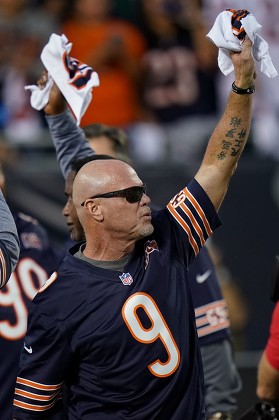In a stunning turn of events that has rocked the NFL world, former Chicago Bears quarterback and fan favorite Jim McMahon has been appointed co-owner of the franchise, marking a full-circle moment in a journey defined by defiance, flair, and unyielding grit. After decades away from the team he once led to Super Bowl glory, McMahon is making a dramatic return—not as a player, coach, or commentator—but as a power figure in the front office. The “Punky QB” is back at Halas Hall, and this time, he’s calling the shots.
The news broke early Thursday morning, with a joint statement from current principal owner Virginia Halas McCaskey and the Bears organization. “Jim McMahon embodies the toughness, individuality, and spirit of Chicago,” the statement read. “His passion for this franchise and for the city has never faded, and today, we welcome him back—not as a legend of the past, but as a visionary of the future.”
It’s a historic move. Not only is McMahon the first former Bears player to ever hold an ownership stake in the franchise, but the appointment signals a paradigm shift for a team long steeped in tradition. The Bears have often clung to their historic identity: Monsters of the Midway, Ditka’s toughness, and a bruising, defense-first mentality. But this decision suggests a willingness to evolve—and it’s being led by a man who has never played by the rules.
Jim McMahon’s tenure with the Bears in the 1980s was nothing short of iconic. Drafted fifth overall in 1982 out of BYU, McMahon arrived in Chicago with a chip on his shoulder and a swagger that turned heads. He wore headbands with rebellious slogans, challenged authority, and openly mocked the league’s rigid dress codes. But he also delivered where it mattered most—on the field. The pinnacle came in the 1985 season, when McMahon led the Bears to a 15-1 record and a dominant Super Bowl XX win, cementing their place as one of the most formidable teams in NFL history.
Despite his success, McMahon’s time in Chicago was tumultuous. He frequently clashed with head coach Mike Ditka and team management, often feeling marginalized and unappreciated. The tension eventually led to his departure in 1989 when he was traded to the San Diego Chargers. Over the years, McMahon was candid about his disillusionment with the Bears organization, once famously declaring, “I don’t even like the people that run the Bears. I just love the fans.”
That makes his return to Halas Hall all the more compelling. It’s not just a business move—it’s a moment of healing, of reconciliation, and of reclaiming a legacy that once felt fractured. Sources close to the organization say that talks with McMahon had been ongoing for months and were spearheaded by younger members of the McCaskey family who were eager to bring fresh perspective into the ownership group. They believed that McMahon’s understanding of the game, his media savvy, and his unique connection with the fan base could be invaluable as the franchise looks to navigate a new era.
The Bears are at a crossroads. With a new stadium on the horizon, ongoing quarterback evaluations, and the weight of a city’s expectations, the front office has been searching for an identity to build upon. McMahon offers that in abundance. He represents not just Chicago toughness, but a boldness and authenticity that resonates in a league increasingly shaped by image consultants and PR teams.
At a press conference held in the Walter Payton Center, McMahon took the podium in vintage form. Wearing a custom Bears blazer and his trademark shades, he addressed a packed room of media, former teammates, and executives. “I never thought I’d be back here like this,” he began, his voice tinged with emotion. “When I left this place, I left angry. I felt like I had more to give, more to say. But time does things. It heals, it humbles, and it brings people back together.”
McMahon went on to outline his vision for the team—not just as a football operation, but as a cultural institution. “We’ve got generations of Bears fans who deserve better—more consistency, more transparency, and more wins. I’m not coming in here to be a figurehead. I’m here to push, to challenge, and to demand excellence. That’s what Chicago expects. That’s what we’re gonna give ‘em.”
Longtime Bears fans see the move as poetic. In many ways, McMahon never stopped being a symbol of the franchise. He was the blue-collar rebel who embodied everything Chicago loves: grit, honesty, and a refusal to back down. Whether he was tossing touchdowns or calling out NFL Commissioner Pete Rozelle, he did it his way. And now, he has the platform to shape the organization from the top down.
The ripple effects are already being felt. Within hours of the announcement, jersey sales featuring McMahon’s name spiked online, and Bears memorabilia featuring the 1985 championship team surged in value. The Bears’ social media team posted a series of throwback highlights, culminating in a new campaign titled “Back to the Future,” showcasing McMahon’s return with the tagline: “Legends Never Leave. They Lead.”
Several current and former players also weighed in. Justin Fields, the Bears’ current quarterback, praised the move on Instagram, writing, “Love this. Jim was a dawg. Let’s make history.” Meanwhile, Hall of Famer Richard Dent said in a local radio interview, “Jim’s not afraid to say what needs to be said. That’s the kind of leadership this place has been missing.”
McMahon’s influence is expected to extend beyond personnel decisions. He’s reportedly interested in revamping the team’s branding, including uniform redesigns, stadium experience improvements, and more direct fan engagement. While the idea of modernization might unsettle some traditionalists, McMahon emphasized that the core values will remain untouched. “We’re not erasing history,” he said. “We’re building on it.”
There are also indications that McMahon may advocate for a more aggressive approach to player welfare, particularly around head injuries—a cause close to his heart. In the years since his retirement, McMahon has been outspoken about his own battles with memory loss, chronic pain, and the need for improved medical support for former players. His platform as a co-owner could allow him to push the NFL toward reforms he’s long championed.
Financial details of McMahon’s ownership stake remain private, but insiders suggest it’s a significant minority share, with the potential for increased influence over time. While he won’t be the majority decision-maker, his voice at the table carries immense symbolic weight.
For a city that has often romanticized its sports heroes, this appointment is more than a headline—it’s a redemption story. It’s about recognizing the impact of a player whose contribution to the Bears went beyond stats and into the soul of the team. It’s about honoring a legacy that once felt left behind, and inviting it to lead the way forward.
As McMahon looked out over the crowd of reporters, many of whom had covered him during his playing days, he cracked a familiar grin. “I used to say I’d never step foot back in Halas Hall,” he said. “Guess I had to buy my way in.”
That line drew laughs, but it also served as a fitting coda to a career—and now a chapter—that has always defied expectation. The “Punky QB” has returned to Chicago, not just to relive the past, but to shape the future. And in a town that still echoes with chants of “Da Bears,” there’s no telling how far McMahon’s second act might go.
One thing is certain: Halas Hall just got a whole lot louder.



